The Best Way to Pack Clothes When Moving
Moving to a new home is an exciting adventure, but packing can be a challenge, especially when it comes to clothing. They are bulky, made of various materials, and are sentimental to each individual. In this guide, we'll explore how to efficiently pack your clothes when moving, so your garments arrive at your new place just as immaculate as they were before - ready to be worn.
19 min read

Key takeaways
- Before packing, declutter your wardrobe and categorise your clothes into keep, donate, and discard piles. This will make packing and unpacking more efficient.
- Consider using cardboard boxes, vacuum bags, suitcases, or wardrobe boxes based on your specific needs. Or try them all!
- Folding is ideal for heavy or structured items, while rolling works well for everyday clothes and soft fabrics.
- Utilise the layering method when packing clothes in boxes. Start with heavier items at the bottom, roll lighter clothes to fill gaps, and place delicate items on top to prevent damage.
- Use garment bags, tissue paper to pack clothes to protect delicate and valuable clothes during the move. Consider keeping these items with you for added security.
- Label your clothing boxes by room, clothing type, or colour to simplify the unpacking process. Proper organisation will save you time and make things easier to find.
- Consider eco-friendly alternatives such as using cardboard boxes, biodegradable packing peanuts, reusable moving bins, blankets, towels, green bubble wrap, and crumpled newspaper. These choices reduce waste and have a positive impact on the environment.
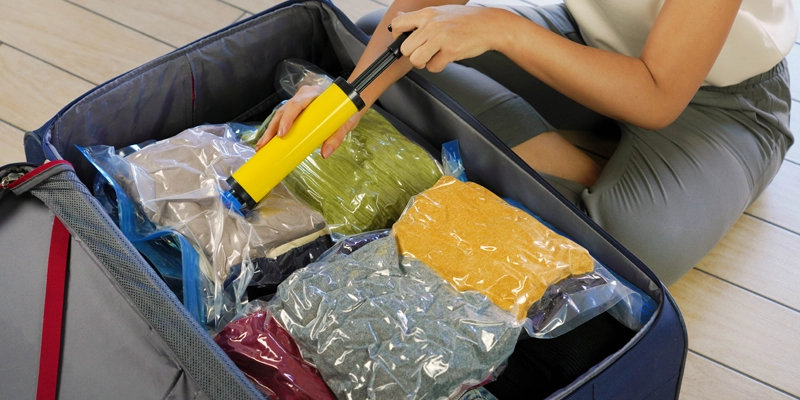 Packing your wardrobe for a big move might seem like an insurmountable task. With every drawer you open, every closet you peer into, the magnitude of the job hits you - that's a lot of clothes to move. Efficient packing is not just about saving space; it's about ensuring that your favourite garments survive the journey without a snag, a tear, or a stain. It's the difference between unpacking a suitcase full of neatly-folded clothes and unearthing a tangled, wrinkled mess at your new home.
Packing your wardrobe for a big move might seem like an insurmountable task. With every drawer you open, every closet you peer into, the magnitude of the job hits you - that's a lot of clothes to move. Efficient packing is not just about saving space; it's about ensuring that your favourite garments survive the journey without a snag, a tear, or a stain. It's the difference between unpacking a suitcase full of neatly-folded clothes and unearthing a tangled, wrinkled mess at your new home.
Let's take a common scenario: you've spent years curating your clothing collection, filled with treasured items each holding a memory. Your trusty black blazer from your first job interview, the dress you wore to your best friend's wedding, or that comfortable pair of jeans perfect for a lazy Sunday. Now imagine reaching your new home, and the joy of unpacking turns into dismay as you find your precious items damaged or discoloured. Therefore, knowing how to pack your clothes efficiently for a move is an essential skill that can save you time, space, and a whole lot of heartache.
1. Preparation and sorting
Before you start packing your clothes, a thorough preparation and sorting process is crucial. You might be tempted to simply pack clothes into a bag, but a little organisation can go a long way in preventing damage and making the unpacking process a breeze.
The importance of decluttering before packing
Start by purging your wardrobe of items you no longer need or wear. Not only does this decrease the volume of clothes you'll be moving, but it also provides a fantastic opportunity to sort out unwanted items to donate to charity.
Use the strategy keep, donate, discard
This three-step plan is as simple as it gets, but it really does the trick. So here's the deal - start by sorting your stuff into three categories: keep, donate, and discard. As you go through each item in your wardrobe, ask yourself: is it a keeper, a donation, or something that's better off in the bin? This way, you'll not only make packing a breeze, but unpacking too. You'll be able to quickly and efficiently organise everything in your new place.
Keep
Items that still fit, are in good condition, and you wear regularly should go into the 'Keep' pile. These are the clothes that will journey with you to your new home.
Donate
There might be pack clothes that are still in decent condition but you don't wear them anymore. Instead of letting them take up space, consider donating them to a charity shop or a clothes recycling box.
Discard
Then come the items that are torn, stained, or worn out. These are clothes that are past their prime and cannot be donated. Discard these responsibly, either through textile recycling or eco-friendly waste disposal.
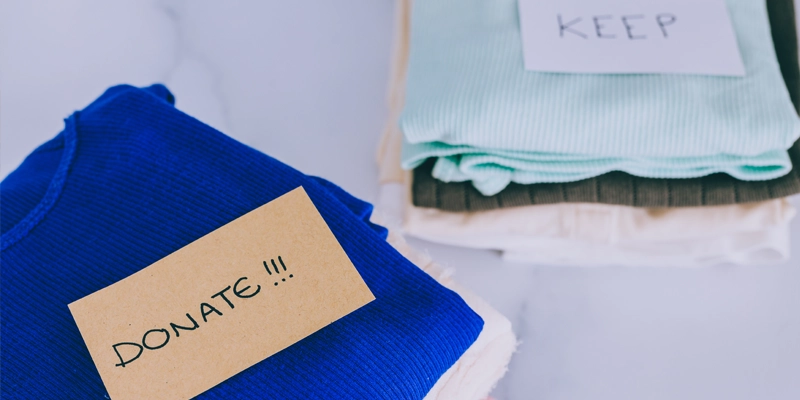
Categorise your clothes
- You can then further organise your clothes by category, such as shirts, trousers, dresses, and jackets.
- By family member such as your children's clothing items and baby and infant clothing items.
- Separate clothes by season or occasion.
Once you've sorted everything out, set aside the delicate items and those that need some extra TLC, like those fancy suits or beautiful wedding dresses in their special garment bags. You know, those delicate fabrics that need a little extra love. By doing this, you can make sure these clothes are well taken care of during the packing process and avoid any potential mishaps on the way.
Prepare an essentials bag
It's also important to remember to set aside an 'essentials' bag with enough pack clothes for the first few days after your move. This way, you won't be in a rush to unpack all your clothes when you first arrive at your new home.
2. Choosing the right containers
Cardboard boxes
Cardboard boxes are the ultimate go-to when it comes to moving. They're super affordable, easy to find, and come in all sorts of sizes to fit your wardrobe needs.
Pros:
- Affordable and easily accessible.
- Available in different sizes for various hanging clothing types.
- Convenient to acquire and use during relocation.
Cons:
- Non hanging clothes stored in cardboard boxes are prone to creasing.
- Can be damaged by moisture or pests if left for a long time.
- Not as durable or long-lasting as other storage options.
Vacuum bags
Vacuum bags are seriously amazing for those bulky items like winter coats, duvets, and towels. They totally squash the air out and shrink them down, saving so much space! It's like magic! So if you're looking to maximise storage, these compression bags are the way to go.
Pros:
- Increased storage space by removing the air, these bags can decrease the volume of your clothes by up to 75%.
- The airtight seal protects your non hanging clothes from external elements like dust, insects, and moisture.
- Vacuum-sealed bags are relatively inexpensive and reusable, making them a cost-effective storage solution.
- Once sealed, the bags are easy to stack and store, making them an efficient choice for those with limited storage space.
Cons:
- Garments can become severely creased when compressed, requiring ironing or steaming.
- Not suitable for delicate fabrics or clothes that can easily lose their shape.
- Vacuum bags may lose their seal over time, allowing air back in and reducing the effectiveness of storage.
Suitcases
Using suitcases for moving clothes has the added advantage of being practical and cost-effective. Plus, chances are you already have a few lying around. And if they have wheels, it's even better - You can easily transport them without breaking a sweat.
Pros:
- Practical and cost-effective.
- Suitcases with wheels offer convenience.
- Ideal for certain folded clothing types like shirts, dresses, and trousers.
Cons:
- Not as effective for bulky items like jackets or winter wear.
- Limited capacity compared to other moving options.
- May require additional packing materials for delicate items.
Wardrobe boxes
Wardrobe boxes are tall, durable boxes designed with a metal bar across the top for hanging clothes. They are perfect for hanging clothes and transporting them with hangers intact.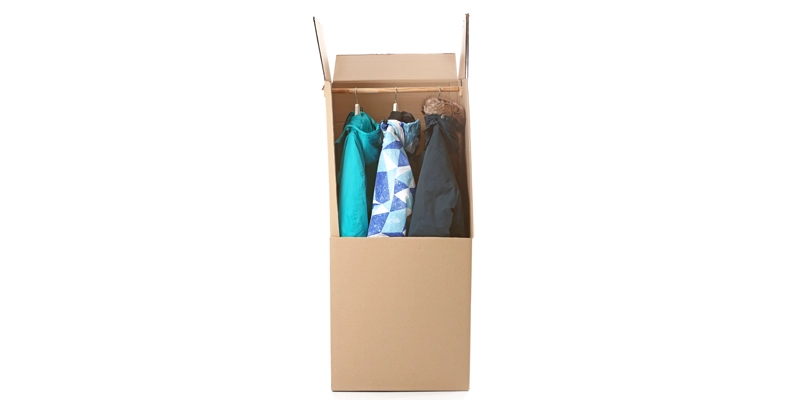
Pros:
- The metal bar that comes with the wardrobe box is ideal for hanging clothes that carry a bit of weight.
- Perfect for transporting all types of hanging clothes such as suits, dresses, and ballroom gowns and sentimental clothing. Don't forget to add the extra layer of protection by enclosing them in garment bags.
- Unparalleled convenience and protection for valuable or delicate items.
Cons:
- Can be more expensive compared to other options.
- Takes up more space due to the tall design of a wardrobe box.
- Limited use for hanging clothing items as opposed to folded clothing.
3. Rolling vs. folding clothes
When it comes to packing clothes for a move, two popular techniques come to mind: folding and rolling. Both methods have their own set of benefits and drawbacks, and the choice largely depends on the type of clothing and personal preference.
Folding clothes
Traditional folding also know as the 'flat fold method' is a standard packing method. Folding clothes is straightforward and doesn't require any special skills or techniques.
Pros:
- Easy to do and does not require any special technique.
- Perfect for packing stiff and heavy clothing like jeans or jackets.
- Nicely packing folded clothing also minimises wrinkles and creases, especially for dress shirts and formal wear.
Cons:
- Not the most space-efficient packing method. Folded clothes tend to take up more room.
- Layering folded clothes can often create more dead air space in the container.
Rolling clothes
The rolling technique, also known as the 'ranger roll' or 'military rolling method', involves tightly rolling individual items of clothing. This method is often used by backpackers and military personnel to save space.
Pros:
- More space-efficient than folding. Rolled clothes can fit into corners and awkward spaces in your suitcase or moving box.
- Allows you to see all items at a glance, making it easier to locate a specific item without disturbing other pieces.
Cons:
- Clothes may get more wrinkles if not rolled tightly and correctly.
- Not ideal for heavy, stiff, or bulky items like jackets or jeans.
If you've got delicate items that wrinkle easily, folding might just be your best bet. But if you're looking for a more space-saving technique, especially for your everyday clothes and soft fabrics, the military rolling method is worth a shot. Give both methods a try to see what works best for your packing needs.
4. Layering clothes in boxes
The layering method involves packing your clothes in layers within a cardboard box or other container you choose to use. This can be a very efficient way to pack your clothes, particularly if you're using a combination of folding and rolling. Here's a step-by-step guide on how to do it:
Step 1: Begin with heavy items
Start with larger, heavier items like jeans, jackets, or jumpers. If you're using the fold method for these, place these items at the bottom of the box. This will provide a solid base for your packing.
Step 2: Roll light clothes
Next, roll your lighter items such as t-shirts, underwear, and socks. These items can be placed in the remaining gaps. By rolling these clothes, you can easily fit them into smaller spaces, utilising the available space effectively.
Step 3: Delicate items on top
Delicate items like silk shirts, blouses, or dresses should be carefully folded and placed on top. This will prevent them from being crushed under the weight of the heavier items.
Benefits of layering clothes
By carefully planning and layering your clothes you can:
- Makes efficient use of the space in the box or container.
- Allows for easy unpacking of clothes if packed in the order you organised them.
- Helps prevent delicate items from being damaged.
5. Special care for delicate and valuable items
Now, you may have some higher price tag designer label clothing and sentimental clothing items that you may want to further protect when it comes to your move, rather than packing them in a moving box with other clothes. So, when it comes to these more delicate and expensive clothing pieces, you've got to handle them with extra care. Let me share a few extra tips how you can pack these clothes to ensure a safe move.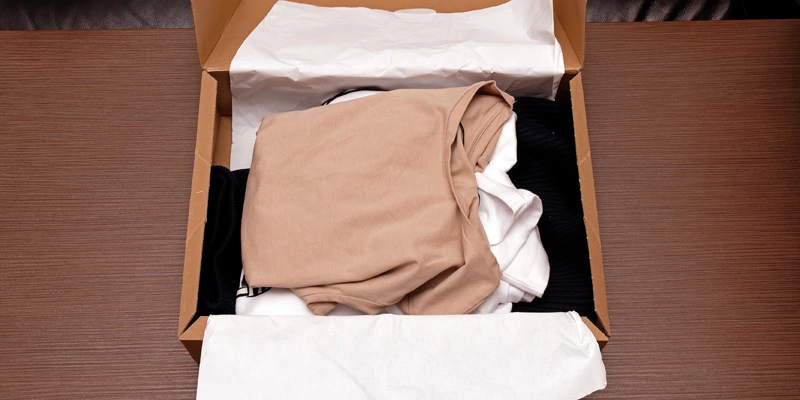
1. Use garment bags: Garment bags are excellent for protecting delicate items and especially to pack hanging clothes. They provide a physical barrier against dust and moisture, and also minimise friction between clothes which can cause wear and tear. They are especially useful for suits, dresses and other formal wear.
2. Use tissue paper: Tissue paper can be used to protect delicate fabrics and prevent wrinkling. Lay the tissue paper out flat, place the item on top, and then fold clothes with the tissue paper. This can be particularly beneficial for items like silk blouses or cashmere jumpers.
3. Don't overpack: Overpacking can lead to crushing and creasing. It's better to allow a little extra space in your suitcase or moving box to avoid squashing your items. Besides the box of clothes will also be much lighter to lift.
4. Use silica gel packs: These are great for absorbing excess moisture that could harm your items, especially in humid environments or during long storage periods.
5. Carry valuable clothing items with you: Where possible, keep valuable items such as designer clothing or accessories with you during the move. This minimises the risk of loss or damage. While it's also important to consider removal insurance for these item specifics that you want to protect.
6. Label your clothing boxes
Labelling your clothing boxes is a critical step in the packing process and should never be overlooked. Properly labelled boxes will significantly simplify the unpacking process, saving you time and stress once you arrive at your new home.
Here are some tips to effectively label your clothing boxes:
1. Label by room: Assign each box to a specific room, such as the master bedroom, kids' room, or guest room. This will enable you to keep track of which clothes belong where, facilitating a more efficient unpacking process.
2. Label by clothing type: You could also organise your boxes based on the type of clothing - for example, separate boxes for work clothes, casual wear, winter clothes, summer clothes, and so on. This method can be particularly useful if you have a diverse wardrobe or if different family members have similar clothing sizes.
3. Use coloured labels: Colour coding can make the identification process quicker. Assign a specific colour to each room or clothing category and stick the corresponding coloured labels on the boxes.
4. Detail the contents: Aside from categorisation, it is beneficial to provide a brief description of the box's contents. This can include details about the specific items or the quantity of clothes inside.
5. Indicate the handling instructions: Don't forget to mark boxes containing delicate items with 'Fragile' or 'Handle with Care' to ensure they receive the necessary attention from the moving company and moving team when they transport clothes. Pack hanging clothes in a wardrobe box for instance is one to label 'Handle with Care.' so the removalists know to transport hanging clothes with care.
Remember, being meticulous while packing can save you a good deal of effort during the unpacking stage. Organised labelling is definitely a small step that makes a big difference!
Related reading: How to Label Moving Boxes: The Ultimate Guide to an Organised Move
7. Seasonal clothing considerations
When packing off-season clothing, it's crucial to factor in long-term storage considerations. Firstly, clean and dry all clothes thoroughly to prevent mould and mildew growth. Grouping off-season clothes together and putting them in clearly labelled boxes can make it easier to locate them when the season changes.
If space efficiency is a concern, consider using vacuum-sealed bags. As discussed earlier, these bags work by removing all the air from the bag, significantly reducing its size. Not only do vacuum-sealed bags save space, but they also protect your clothes from dust, odour, insects, and moisture, making them an excellent option for storing off-season clothes. Here's how you can use them:
- Fold or roll your clothes and place them in the bag.
- Seal the bag using the slider provided.
- Use a vacuum cleaner to suck out all the air from the bag through the valve.
- Once all the air is removed, cap the valve to maintain the vacuum seal.
Keep in mind, while vacuum-sealed bags are incredibly space-efficient, they can cause creasing or damage to certain delicate items. It's best not to use them for hanging clothes that wrinkle easily or have embellishments that could be damaged under pressure.
8. Packing shoes and accessories
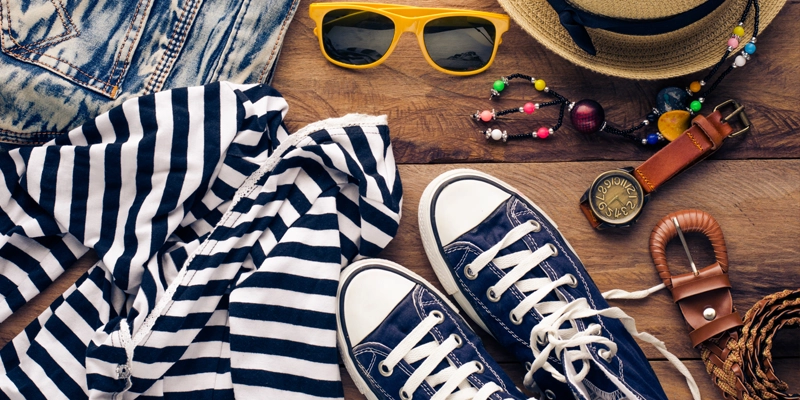 Packing shoes and accessories is no less important than packing clothing items. With shoes, belts, hats and other accessories often coming in awkward shapes and sizes, it can be tricky to know how to pack them efficiently without causing any damage. Here's what you need to do:
Packing shoes and accessories is no less important than packing clothing items. With shoes, belts, hats and other accessories often coming in awkward shapes and sizes, it can be tricky to know how to pack them efficiently without causing any damage. Here's what you need to do:
1. Clean your items: Before you start packing, make sure all items are clean. Mud, dirt or grime can damage other items in the box, so it's best to clean shoes and accessories thoroughly before packing them.
2. Use shoe bags or boxes: Shoe bags or boxes can be an excellent way to pack shoes. They keep the shoes separate from each other, preventing scuffing, and they can be easily stacked in a suitcase or moving box. If you don't have any shoe boxes to hand, wrapping shoes in old newspaper or bubble wrap can also help protect them.
3. Fill shoes with paper: Filling shoes with paper helps them to keep their shape during transit. Just stuff some old newspaper or packing paper into the shoes before you pack them.
4. Roll belts and ties: Belts and ties can be easily rolled up to save space. Just start at one end and roll it up, securing with a rubber band or tie clip if necessary.
5. Pack hats in boxes: To protect hats from being crushed, it's best to pack them in hat boxes. If you don't have a hat box, you can use any sturdy box that is large enough to fit the hat without squashing it.
6. Use small containers for tiny accessories: For smaller accessories like jewellery, scarves or gloves, use small containers or zip-lock bags to keep everything together and prevent them from getting lost.
7. Organise items by type: Just like clothes, it's useful to organise accessories by type. Keep all shoes together, all hats together etc., so you know exactly where to find everything when you're unpacking.
8. Label all boxes and containers: Don't forget to label all boxes and containers clearly. You don't want to arrive at your new home and have no idea where to find your favourite pair of shoes or your favourite hat.
By following these best practices, you can ensure that your shoes, belts, hats and other accessories will arrive at your new home in the best condition possible.
9. Packing kids' and baby clothes
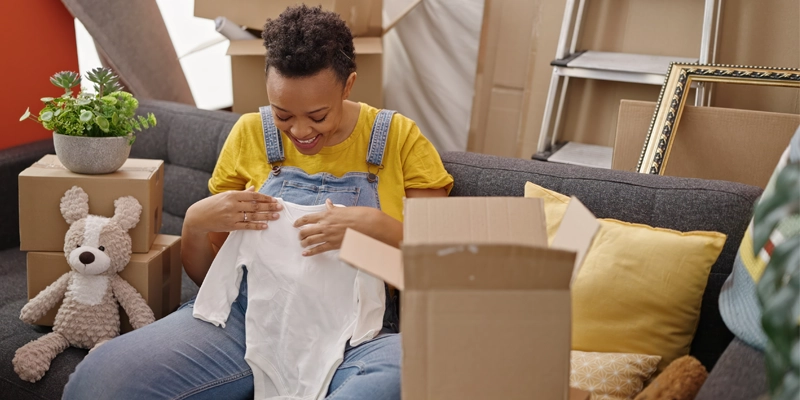 Packing children's and baby clothes requires special attention due to their size and the sheer volume of items. Here are some tips to make the process smoother and more efficient:
Packing children's and baby clothes requires special attention due to their size and the sheer volume of items. Here are some tips to make the process smoother and more efficient:
1. Use smaller boxes: Kids' clothes are smaller, so using large boxes can lead to disorganisation. Smaller boxes will help keep items tidy and prevent them from getting lost in the shuffle.
2. Prioritise essentials: Pack a separate bag with essentials like nappies, wipes, bibs, and a few changes of clothes. This will be particularly useful during the moving process and in the first few days after you arrive at your new house when unpacking might not be your first priority.
3. Involve the kids: If your children are old enough, involve them in the packing process. This can make them feel included and excited about the move. Let them decide on their favourite clothes to pack in their personal bags for the journey.
4. Keep safety in mind: Remember to check pockets for small objects that could pose a choking hazard. Additionally, to prevent accidents, keep sharp objects such as safety pins away from children's reach.
5. Use clear plastic bags: For baby clothes, consider using clear plastic bags to easily identify each outfit. This is especially useful for tiny items like socks and hats that can get lost easily.
6. Label by category: Label boxes with categories like 'school clothes', 'play clothes', 'winter clothes', etc. This can make the unpacking process easier and more efficient.
Packing your kids' and baby clothes can be a breeze if you follow these tips. Just remember, the key to smooth packing is staying organised and getting the whole family involved. It can make a world of difference, if you have the help.
10. The essentials and last-minute packing
The essentials box, also known as a survival box, should contain items you'll need immediately upon reaching your new home. It's critical to curate this box wisely, as scrambling through boxes to find essentials after a tiring move can be frustrating. Here are some items to include:
1. Toiletries: Pack items such as toilet paper, soap, shampoo, toothbrushes, and toothpaste. Don't forget personal hygiene products and towels.
2. Kitchen essentials: Include disposable plates, cups, cutlery, a pot and pan for simple meals, a few non-perishable foods, a can opener, and some cleaning supplies. Also, consider packing tea bags or coffee to revive yourself after the move.
3. Basic tools: A small toolkit with a hammer, screwdriver, scissors, a set of Allen keys, and a box cutter can be invaluable for initial setup tasks.
4. Clothing: Pack a few changes of clothes and sleepwear for each family member. Including underwear and socks. It's crucial to wind down and feel comfortable after your very first shower following a move.
5. Medication: Add a first aid kit and any regular medication required by family members.
6. Important documents: Keep your passports, ID cards, house documents, and other essential paperwork in this box.
7. Entertainment: A book, toy, or game can keep kids occupied while you're busy setting up.
8. Electronics and chargers: Include necessary electronics like phones, laptops, and their chargers.
9. Bedding: If possible, pack some basic bedding to ensure a comfortable first night.
Remember to move the essentials box with you, so that you have it with you at all times and this will also allow you immediate access to it in your new home. Label it clearly and keep it separate from the rest of your items.
Last-minute packing
In the flurry of moving, last-minute packing can often become a chaotic task. Here are some strategies to make this process efficient and stress-free:
1. Quick sorting: Start a rapid sort of your items into 'necessary', 'maybe' and 'not-needed' piles. Items in the 'not-needed' pile can be sold, donated or discarded accordingly.
2. Gather packing materials: Gathering all your packing materials such as boxes, bubble wrap, packing tape, and markers can save you from unnecessary stress. Always keep extra materials handy for unforeseen needs.
3. Use what you have: At the eleventh hour, if you find you are missing some key packing supplies such as garment bags, use what you can such as large garbage bags. Simply cutting a hole at the bottom to for the hanger to protrude makes an excellent garment bag. Or if you need extra storage for clothing, duffle bags or a laundry basket will do.
4. Pack room by room: Tackle one room at a time to avoid mixing items from different rooms, which can cause confusion when unpacking.
5. Utilise luggages: Suitcases, duffel bags, and even laundry baskets can serve as excellent packing containers for last-minute packing. They are especially useful for packing clothes, books, and other non-fragile items.
6. Don’t empty drawers: If the furniture is sturdy, consider leaving the drawers intact. This saves time and box space. You can transport the drawers of pack folded clothing separately from your freestanding wardrobe to make it lighter. Otherwise, remember to secure the drawers to prevent them from sliding out during the move.
7. Use clothes for wrapping: Use towels, bedsheets, and clothes to wrap fragile items. This technique offers dual benefits - it safeguards your breakables and packs your clothes simultaneously!
8. Essential bag: Keep an essentials bag for each family member with necessary items like toiletries, a change of clothes, medication, important documents, and any other personal necessities. These will be the bags you need immediately in your new home.
9. Label properly: With time being a constraint, proper labelling of boxes indicating the room they belong to and a hint of the contents inside will assist tremendously during the unpacking process.
In the midst of the rush, don't forget to take care of yourself. Ensure you stay hydrated, eat well and get enough sleep. After all, moving is not just about packing boxes, but also about starting a new chapter in a new place.
11. Unpacking and organising clothes in your new home
 When you've finally arrived at your new home and ready to unpack and organise your clothes, remember all the hard yards have been done already. This is where you get to start fresh and organise your clothes as you please. If you are moving into a house with extra built in wardrobe space, maybe start with your hanging clothes, and build up your excitement of filling up the rest of the wardrobe space you've got to work with.
When you've finally arrived at your new home and ready to unpack and organise your clothes, remember all the hard yards have been done already. This is where you get to start fresh and organise your clothes as you please. If you are moving into a house with extra built in wardrobe space, maybe start with your hanging clothes, and build up your excitement of filling up the rest of the wardrobe space you've got to work with.
1. Prioritise: Start unpacking with the clothes you'll need immediately. This usually encompasses everyday wear and work or school clothes. Special occasion outfits and seasonal clothes can wait until the end.
2. Organise by family member: To avoid confusion, unpack and organise each person's clothes separately. It will make the task easier and more efficient.
3. Utilise closet organisers: Utilise dividers, packing cubes, bins, and hangers to organise and pack folded clothes in your closets. They help maximise storage space and keep clothes neat and orderly.
4. Sort by type and colour: Sorting clothes by type (t-shirts, jeans, dresses, etc.) and colour can make it easier to locate what you want to wear. It also gives your closet a pleasing aesthetic.
5. Handle delicate clothing with care: Be careful while unpacking delicate items like designer wear, silk clothes or lace materials to prevent damage. Hang them or fold them neatly and place them in separate dresser drawers or box.
6. Donate unwanted clothes: If while unpacking, you stumble upon clothes that no longer fit or are out of fashion, consider donating them. This will reduce clutter in your new home.
Remember, it's okay to take your time when unpacking. It's more important to organise things properly the first time around than to rush and have to redo it later.
12. Sustainable packing options
In an era of environmental consciousness, exploring sustainable packing supplies has become imperative. It's a question of how to pack clothes for moving with sustainable packing supplies and here are a few options:
1. Cardboard boxes: These are commonly used, recyclable, and can be sourced second-hand from local businesses, reducing waste or storage facilities selling seconds. Including some second wardrobe boxes.
2. Biodegradable packing peanuts: Unlike traditional polystyrene peanuts, these are made from natural, non-toxic sources like corn starch and decompose over time.
3. Reusable moving bins: These plastic bins can be rented, used, and returned, thereby reducing the consumption of cardboard.
4. Blankets and towels: Utilise your soft belongings as wrapping materials for fragile items, eliminating the need for bubble wrap.
5. Green bubble wrap: This is a recyclable alternative to regular bubble wrap, made from recycled polyethylene.
6. Crumpled newspaper: An excellent cushioning material for delicate items, newspapers are widely available and recyclable.
7. Moving or duffel bags: A reusable moving of duffel bag can be used to pack non hanging clothes or other non-fragile items, instead of using cardboard boxes.
6. Plastic storage containers: Durable and reusable, these containers can be used to pack clothing items that will remain in storage after the move and repurposed to store other items when no longer needed for clothing.
Choosing eco-friendly packing materials not only minimises your environmental footprint but also can save you money. Remember to recycle or donate your packing materials once you're settled in your new home. Sustainability doesn't have to end with the move; it's a lifestyle choice that can continue in various aspects of your new home life.
Final thoughts
It may feel like an overwhelming task when you're faced with a mountain of garments, each one holding a memory or a special meaning. But if you've gotten this far into our guide on how to pack clothes when moving. Then you're well equipped with some efficient packing strategies so you can conquer this challenge. Just remember, preparation and sorting are key, so take the time to declutter and sort your wardrobe. This is your chance to Marie Kondo your life! You've learnt to only keep the items that you truly love, wear regularly, and are in good condition. How to categorise your clothes to help make unpacking a breeze. What packing options are best for what and the differences between rolling or folding your clothes.
You've come to understand that some delicate clothes, deserve some extra TLC and what extra packing material you can use to best protect them. Labelling your clothing boxes is a must and don't forget to mark wardrobe boxes containing delicate items as "Handle with Care" to alert movers or anyone handling them.
Remember, Rome wasn't built in a day, and neither will your perfectly organised wardrobe. Take it one step at a time, and before you know it, you'll have conquered the challenge of packing clothes for your move. So, take a deep breath, put on some tunes, and let's start packing clothes!
We love to hear from you
We also invite you to share your own moving experiences, tips, and tricks. Hearing real-life stories from our readers not only enriches our community but also helps others who are about to embark on the moving journey. Have you discovered a clever packing hack? Or perhaps you've found a creative way to make unpacking less daunting? We'd love to hear from you!
For more practical advice on moving or simply finding a removalist to help with your move, we encourage you to visit findamover.com.au. It's a treasure trove of resources designed to make your moving process as efficient and stress-free as possible.
Ready to Move? Find Your Perfect Mover!
Don't let moving stress you out. Compare quotes from our network of reliable movers, read genuine reviews, and book with ease. Save time, save money, and start your move with confidence today.
- Quickly compare movers
- Read verified reviews
- Book online with confidence
